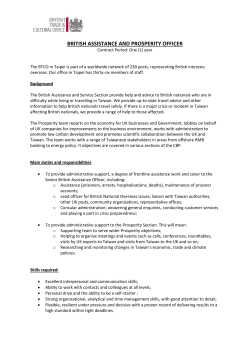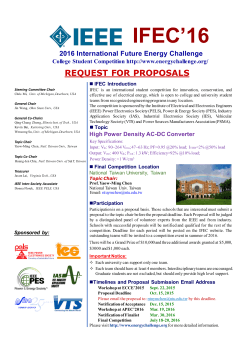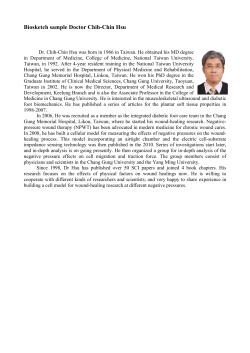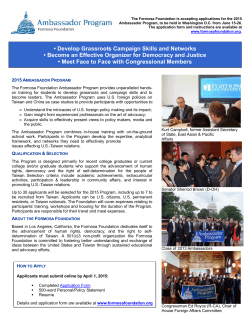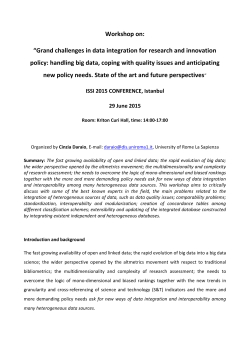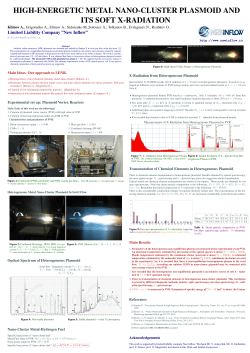
Call for Papers - ieee globecom 2015
IEEE International Workshop On Heterogeneous Carrier Communication Technologies (HetCarrierCom) (in conjunction with IEEE Globecom 2015) http://faculty.csie.ntust.edu.tw/~smcheng/HetCarrierCom2015/index.html Organizing Committee Chih-Cheng Tseng, National Ilan University, Taiwan Shao-Yu Lien, National Formosa University, Taiwan Shin-Ming Cheng National Taiwan University of Science and Technology, Taiwan Mohammed Atiquzzaman University of Oklahoma, USA Marios Kountouris Huawei Technologies, France Technical Program Committee Po-Hsuan Tseng, National Taipei University of Technology, Taiwan Jemin Lee, Singapore University of Technology and Design, Singapore Chih-Yu Wang, Academia Sinica, Taiwan Shaodan Ma, University of Macau, China David López Pérez, Bell Labs – Alcatel Lucent, Ireland Nikolaos Pappas, Linköping University, Sweden Husheng Li, University of Tennessee, USA Hwang-Cheng Wang, National Ilan University, Taiwan Fang-Chang Kuo, National Ilan University, Taiwan Kuo-Chang Ting, Mingsing University of Science and Technology, Taiwan Beatriz Soret Alvares, NSN, Denmark Keynote Speakers Li-Chun Wang, National Chao Tung University, Taiwan Ying-Chang Liang, I2R, Singapore Chih-Lin I, China Mobile Research Institute, China Paper Submission Guidelines All final submissions should be written in English with a maximum paper length of six (6) printed pages (10-point font) including figures without incurring additional page charges (maximum 1 additional page with over length page charge of USD100 if accepted). Papers exceeding 7 pages will not be accepted at EDAS. Important Dates Paper submission: July 1st, 2015 Acceptance Notification: Sept. 1st, 2015 Camera-Ready: Oct. 1st, 2015 Call for Papers The explosion in the number of mobile users and the use of diverse bandwidth-hungry wireless applications have resulted in an exponential growth in the demand for wireless access to the Internet. As a consequence, not only the volume of mobile data traffic is overwhelming the capacity of existing wireless communication networks, but the required high data rates also drains the limited radio resources. Theoretically, one of the possible solutions to this problem is to broaden the amount of allocated spectrum. However, spectrum for commercial use solely in the conventional licensed bands or ISM unlicensed bands is no longer sufficient to support the practical and constantly increasing needs. This in turn decreases the feasibility of this solution and renders the interests of network operators. Hence, heterogeneous carrier communication technologies have received lots of attention from both industry and academia for data communications and telecommunications in recent years. Heterogeneous carrier communication technologies enable the network to operate not only on homogeneous carriers, but also on carriers with different characteristics. For example, in licensed-assisted access (LAA) of LTE (also known as LTE-U), both licensed and unlicensed carriers are involved in, where licensed carriers are used for control channels, while unlicensed carriers are used for data channels. For IEEE 802.11af, communication is no longer carried out on ISM bands and are extended to TV bands. For IEEE 802.11ac (also known as the fifth generation of WiFi), a higher order modulation (256-QAM), wider bandwidth (up to 160MHz), and 8X8 MIMO are adopted for indoor communications. Furthermore, communication using mmWave carriers has recently received considerable attention due to the possible advantages of using wider bandwidth and the potential significant gains. Although these innovative technologies provide new communication paradigms enjoying wider bandwidth and/or stronger signal strength, they also come with challenging technical issues to overcome. The goal of this workshop is consequently to bring together academic and industrial researchers in an effort to identify and discuss the major technical challenges, recent results, and future research issues related to existing and emerging technologies for heterogeneous carrier communication. Topics of interest (include but are not limited to) LAA in LTE (LTE-U) Technology Evolving of IEEE 802.11 (e.g., ac, af, ax), IEEE 802.15, IEEE 802.16, IEEE 802.22 Communications on mmWave carriers Interference and radio resource managements for heterogeneous carrier communications Cloud (heterogeneous) radio access network architecture supporting heterogeneous carriers PHY/MAC/network layer design QoS, energy efficiency, spectrum efficiency issues Offloading, handoff, and network selection among heterogeneous carriers Coexistence of heterogeneous carriers technologies Emerging applications and services, standardization progress, modeling and simulation methods, and performance evaluation
© Copyright 2025

